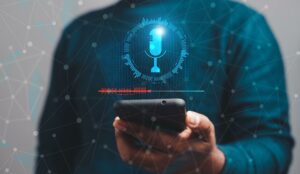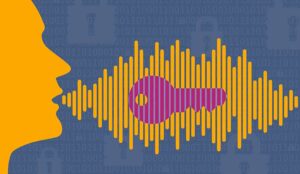Our experts take an in-depth look at what is Voice Biometrics and how it can benefit your contact centre.
What is Voice Biometrics?
Voice Biometrics is essentially a voice signature, allowing customers to “speak on the dotted line”.
Voice Biometrics software identifies a person through their unique voiceprint. In the same way that everyone has a unique fingerprint or retina, voice biometrics technology is used to identify a person through their voice patterns.
Each person’s voiceprint is created based on the physical characteristics of the throat and mouth and this is then used by the system to validate their identify on subsequent phone calls.
No two voices are the same; even identical twins have different voice patterns.
After all, we can all recognise our partner’s and friends’ voices quickly and with a high degree of certainty. Most of us can probably also identify our boss and several work contacts within the first few seconds of a conversation.
To put it simply, because of its unique nature, voice can serve as a password, facilitating authentication processes and decreasing the risk of fraud for both organisations and their customers.
How does it work?
Voice Biometrics uses each customer’s voice as their spoken identifier, measuring characteristics such as pitch and rhythm to create a “fingerprint” unique to that voice.
These voiceprints are made using voice biometrics technology that analyses more than 50 unique physical traits of the vocal tract, such as mouth shape and size, nasal passages, as well as behavioural factors including pronunciation, emphasis, speed of speech and accent.
This enrolment process is usually carried out automatically via a voice portal, where customers call a number and are guided through the process of providing enough speech to create a voiceprint.
The contact centre uses their existing call recording systems to create a unique voiceprint for every customer and stores them in a Customer Voiceprint Database (this can be done through a process known as passive enrolment, meaning the customer is not required to do anything).
The system stores no actual voice recordings, so even in the unlikely event that someone gets access to the system, they are no closer to making fake calls.
Once a voiceprint is created, the system requires just a small sample of speech to identify someone, and this is usually provided by a normal initial meet and greet dialogue.
Therefore, when the customer calls again, a matching algorithm is used to compare new voice data with existing data on file. A decision process is then employed to make a system-level decision on customer authentication. If a match is verified then the customer is authenticated.

Their voice is usually matched with the voiceprint kept on record within 10 seconds.
The Voice Biometrics system also stores the voiceprints of known fraudsters in a database and screens incoming calls, proactively notifying the live agent and/or fraud management system upon detection.
The key to this new generation of voice biometrics is its “passive” operation. Calls are silently screened, and no additional questions are asked in order to match voiceprints. Agents proceed normally until they are alerted to any fraudster detection by the system.
Key features
Voice Biometrics is best used as part of a multi-layered security approach, but may be an improvement to system security as well as offering an improved customer service experience.
There are two main implementations of the technology, ‘active’ and ‘passive’.
Contact centres can either carry out an explicit check on a person’s identity, by asking the caller to repeat a phrase or sentence (active). Or they can simply run the check in the background while the agent and caller are in conversation (passive).
Depending on the type of transaction required, an organisation can alter the level of security applied, perhaps using just voice biometrics for a balance check but requiring further security factors for other transactions.
Which areas of the contact centre can it help to improve?
Create an effortless, less frustrating customer experience
Let me ask you this… How often have you forgotten a password, memorable place or your favourite pet?
The standard verification process can take up to a couple of minutes and can often become a source of frustration if it requires a reset or verification has failed. Even worse, it can make you feel and sounds suspicious if you take a couple of seconds too long to remember the answer to any of those questions.
Voice Biometrics offers a different level of service compared to forcing customers through a tiresome script every time they want to engage.
The biggest single benefit is that customers no longer have to remember a secret word, memorable phrase or password, they just need their voice.
More opportunity to build rapport
Authentication using the traditional verification methods can take up to two minutes to complete, so an almost real-time confirmation will have immediate benefits.
From an agent’s point of view, it means empathy and customer service can be delivered almost immediately. It can also allow the agent to concentrate better on callers’ requests.
This is particularly beneficial when lengthy manual verifications can delay the opportunity to up-sell or deal with the root cause of the call.
A proactive anti-fraud measure
Voice Biometrics can also act as a proactive anti-fraud measure by enabling you to create a blacklist of known fraudsters and stop them as they call.
This works by matching callers against a database of the digital voice “signatures”.
Voice Biometric solutions also have the capability to track an individual fraudster’s voice even as they call across multiple accounts and time periods.
With this intelligence, the contact centre can gain important visibility into fraud patterns and details that weren’t available previously via a single source. These insights can be used to further improve security and efficiency.
A reduction in Average Handling Time (AHT)
Although it may take only a few seconds per call, customer authentication can comprise up to 25% of average handle time. When multiplied across millions of calls a year, this process constitutes significant operational cost for the contact centre.
Reduce this time and you can handle more calls in the same timeframe.
This can help to improve the customer experience as, according to research from Sabio, 49% of users consider knowledge-based authentication to be time-consuming.
It is also estimated that £10 million ($15 million) can be saved on average over a 3-year period as a result of adopting Voice Biometrics.
Enabling other secure services, including self-service password resetting
Voice Biometrics can also be used for self-service password resetting, digitally voice-signing electronic documents, gaining access to secure systems, providing secure access to remote systems and verifying that a customer is at their claimed location.
What to watch out for (disadvantages)
Voice Biometrics does require the individual to enrol or provide an initial voiceprint to enable the authentication going forward. The technology relies on this enrolment to build up a bank of digital signatures.
There are two types of enrolment:
- Auto enrolment – individuals are automatically enrolled in the Voice Biometrics technology.
- Optional enrolment – the individual has the choice or is asked whether they want to join the Voice Biometrics programme.
The enrolment process needs to be carefully implemented to ensure successful early adoption by customers.
Studies have found that if customers are given the choice, the take-up for Voice Biometrics is low, which can impact on the return on investment for the technology.
For an organisation considering the technology, the enrolment and educational strategy is key, particularly if a business case is required to justify the expense.
Voice Biometrics can also expose vulnerabilities in customers’ passwords.
In addition, if a customer cannot provide enough vocal energy to be heard, it is not possible to verify them through voice biometrics.
Voice Biometrics isn’t for everyone, nor every organisation. Our advice would be to follow the 80:20 rule and see if it could be used for the 20% who generate the majority of calls.
Alternatively, it could be something you want to offer your most valued customers in order to provide a better customer experience.
Like anything, Voice Biometrics should be aligned with what your own customers want, as some customer segments may not like it or may consider it a step too far.
How much should I budget?
For a 150-seat contact centre, you should budget between £100,000 and £200,000. The exact figure will depend on how the solution is deployed.
Costs to deploy will vary considerably based on the project scope and any systems integration required.
Any business case needs to include both the quantifiable benefits as well as the less tangible benefits of lower customer effort scores and improved customer experiences.
Thanks to the contributors who helped supply the information for this article (photographs left to right):
- David Evans at Business Systems
- Keith Wilkinson at Genesys
- Craig Pumfrey at NICE Systems
- Stuart Dorman at Sabio
- Mark Lazar at Verint
- James Glasspool at VoltDelta International

Author: Megan Jones
Published On: 22nd Apr 2015 - Last modified: 12th Aug 2025
Read more about - Technology, An Introduction to Contact Centres, Biometrics, Business Systems, Customer Experience (CX), Genesys, NiCE, Rob Wilkinson, Sabio, Speech Recognition











































